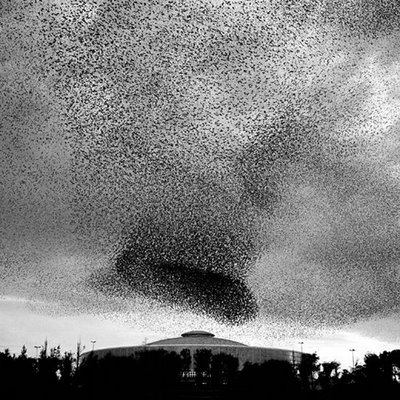Richard Barnes
Sunday, 21 June 2009
Work from the series Mumur.
Last week at a Thai restaurant, I had a sterling land on my plate of Pad Ga-Proa and eat some of my dinner. Thankfully I had finished, but other diners at the establishment did not share my fortune.
“European starlings have a way of appearing in unexpected places — the United States, for example, where they are not native but owe their origin to a brief reference in Shakespeare’s “Henry IV, Part 1.” In 1890, a drug manufacturer who wanted every bird found in Shakespeare to live in America released 60 starlings in Central Park. After spending a few years nesting modestly under the eaves of the American Museum of Natural History, they went from a poetic fancy to a menacing majority; there are now upward of 200 million birds across North America, where they thrive at the expense of other cavity nesters like bluebirds and woodpeckers, eat an abundance of grain — as well as harmful insects — and occasionally bring down airplanes.
In Europe, where the birds are native — Mozart had a pet starling that could sing a few bars of his piano concerto in G major — they still have the power to turn heads. Each fall and winter, vast flocks gather in Rome. They spend the day foraging in the surrounding countryside but return each evening to roost. (Rachel Carson, author of “Silent Spring,” called the birds reverse commuters.) They put on breathtaking aerial displays above the city, banking in nervous unison, responding like a school of fish to each tremor inside the group.
The birds are beloved by tourists and reviled by locals — understandably, since the droppings cover cars and streets, causing accidents and general disgust. A flock of starlings is euphoniously called a “murmuration,” but there is nothing poetic about their appetites. Their ability to focus both eyes on a single object — binocular vision — allows them to peck up stationary seeds as well as insects on the move. In the countryside outside Rome, they feast on olives. Like us, the birds are enormously adaptable but what we admire in ourselves we often abhor in our neighbors.
Richard Barnes’s photographs capture the double nature of the birds — or at least the double nature of our relationship to them — recording the pointillist delicacy of the flock and something darker, almost sinister in the gathering mass. Many of Barnes’s photographs, which will be shown at Hosfelt Gallery in New York this fall, were taken over two years in EUR, a suburb of Rome that Mussolini planned as a showcase for fascist architecture. The man-made backdrop only enhances the sense of the vast flock as something malign, a sort of avian Nuremberg rally.
It is, of course, natural for birds to surrender individual autonomy to the flock; according to the Roman ornithologist Claudio Carere, who has identified 12 basic flock patterns, the starlings are primarily trying to evade falcons. But we project onto the natural world a large measure of ourselves. In ancient Rome, augurs studied the flight patterns of birds to divine the will of the gods; part of the fascination of the starlings is the way they seem to be inscribing some sort of language in the air, if only we could read it.
A consortium of ornithologists, physicists and biologists in Italy and other European countries has in fact begun studying the birds with the aim of learning not only about the relationship of individual birds to the surrounding flock but about human behavior as well. The project, named StarFLAG, entertains hopes of using the birds to illuminate herding responses in human beings with a particular eye on stock-market panics.
The starling in “Henry IV” that inspired those first American birds is a mimic, capable of tormenting a king by speaking the name of Mortimer. Mozart’s bird sang his own music back to him. But Mozart may also have smuggled a few of the bird’s notes into his own compositions. When humans contemplate animals, the question is always who is imitating whom. The starlings that so plague us in America (where we kill more than a million of the birds a year) grew out of our desire for nature to be poetic, rather than truly wild; they reflect the consequences of such self-serving fantasies. It isn’t their fault that they treated an open continent much as we ourselves did.
More and more, as surrounding habitat is flattened, we may find fragments of the wild world coming home, literally, to roost. The abundance of starlings in Rome is partly the result of climate change — they used to go farther south before Roman winters warmed up. Bird-watching thrives on the recognition that the urban and the wild must be understood together. We are, after all, urban and wild ourselves, and still figuring out how to make the multiple aspects of our nature mesh without disaster.” – Richar Barnes



